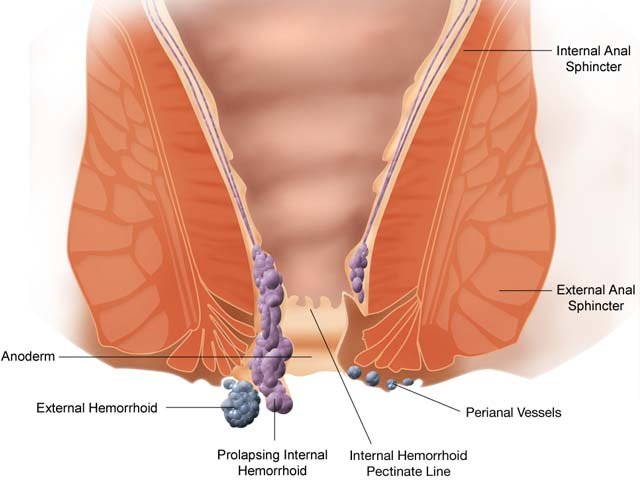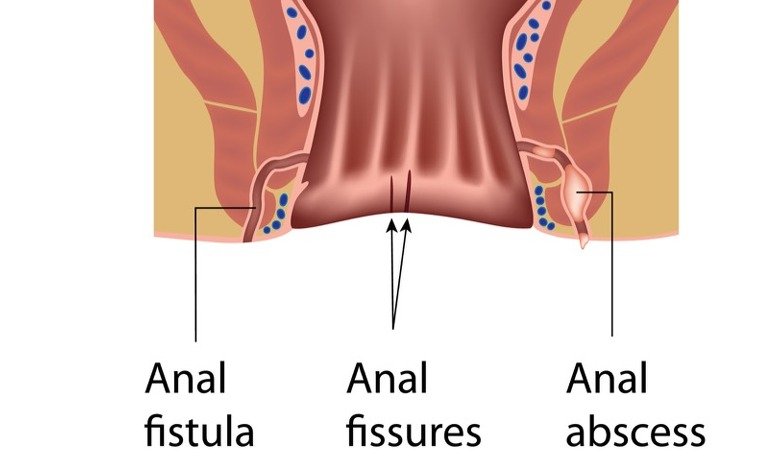Piles, Anal Fissure & Fistula
Piles
Also called as Hemorrhoids, Piles are caused due to excessive swelling that arises inside and around the back passage (anus) and the anal canal. Situations that can develop piles are constipation, pregnancy, ageing, hereditary factors, heavy lifting or even chronic cough.
Symptoms
• Bright red blood after a bowel movement
• Itchiness around anus
• Lump in or around your anus
• Mucus discharge when emptying the bowels
• Pain while defecating
Cure
Most piles don't need surgery. Surgical treatments for piles are an option if you have severe piles, other treatments haven't worked, or your piles keep bleeding. There are different types of surgeries, including the ones below.
• In haemorrhoidectomy, any piles causing problems are carefully removed by making incisions around the haemorrhoid. The patient can usually go home in a day in this surgery.
• In stapled haemorrhoidopexy or Minimally Invasive procedure for hemorrhoids (MIPH), the area of tissue with piles is stitched higher up your anal canal. This means your piles won't come out from your anus anymore and will shrink. The advantages of MIPH over conventional surgery are minimal pain, faster recovery, short procedure, minimal blood loss, no external cuts and lowest recurrent rate.
Anal Fissure
A crack or tear in the lining of the lower rectum (anal canal) is called as anal fissure. It can be very painful and may occur while passing large and hard stools, repeated diarrhea or strains during childbirth. Anal fissures are of two types- Acute and Chronic.
• Acute do not last longer than 6 months and can be self-cured
• Whereas chronic last longer than 6 weeks and need medication or even surgeries to heal.
Symptoms
The overall risk of laparoscopic gallbladder surgery is very low. The most serious possible complications include:
• Stinking and burning sensations during bowel moments.
• Itching
• Dark red blood mixed with stool may be a sign of a more serious problem.
• Pain after bowel movements that can last up to several hours
• Visible crack in the skin around the anus
Cure
• Increasing intake of fiber and fluids
• Soaking oneself (Anus area) in warm water for 15-20 minutes several times a day
• Topical anesthetic creams or nitroglycerin can be applied externally for some relief in pain.
• If the medication remains ineffective then minimally invasive surgical procedure called lateral internal sphincterotomy (LIS), which involves cutting a small portion of the anal sphincter muscle to reduce spasm and pain, and promote healing is recommended by the surgeons. Its advantages involve faster recovery time, smaller incisions and lesser time in hospital.
Fistula
A small channel with its internal opening in the anal canal and its external opening in the skin near the anus is anal fistula. An infection near the anus causing abscess in the nearby tissue, Crohn's disease, diverticulitis, infections from Tuberculosis (TB) can be reasons of anal fistula.
Symptoms
• Skin irritation
• Swelling and redness around anus
• Bowel incontinence
• High fever
• Constant pain that may be worse when you sit down, move around, have a bowel movement or cough etc
Cure
• Fistulectomy is a common mode of surgery in which fistula tract is cut out to cure the disease.
• VAAFT or Video Assisted Anal Fistula Treatment is used for healing of intricate fistulas and their reappearances. This technique comprises two phases: a diagnostic one and an operative one.
The advantages of VAAFT treatment are-
• No surgical wounds
• Complete certainty in the localization of the internal fistula opening
• Complete destruction of fistula from the inside
• No damage is caused to the anal sphincters
• Risk of postoperative fecal incontinence is excluded




